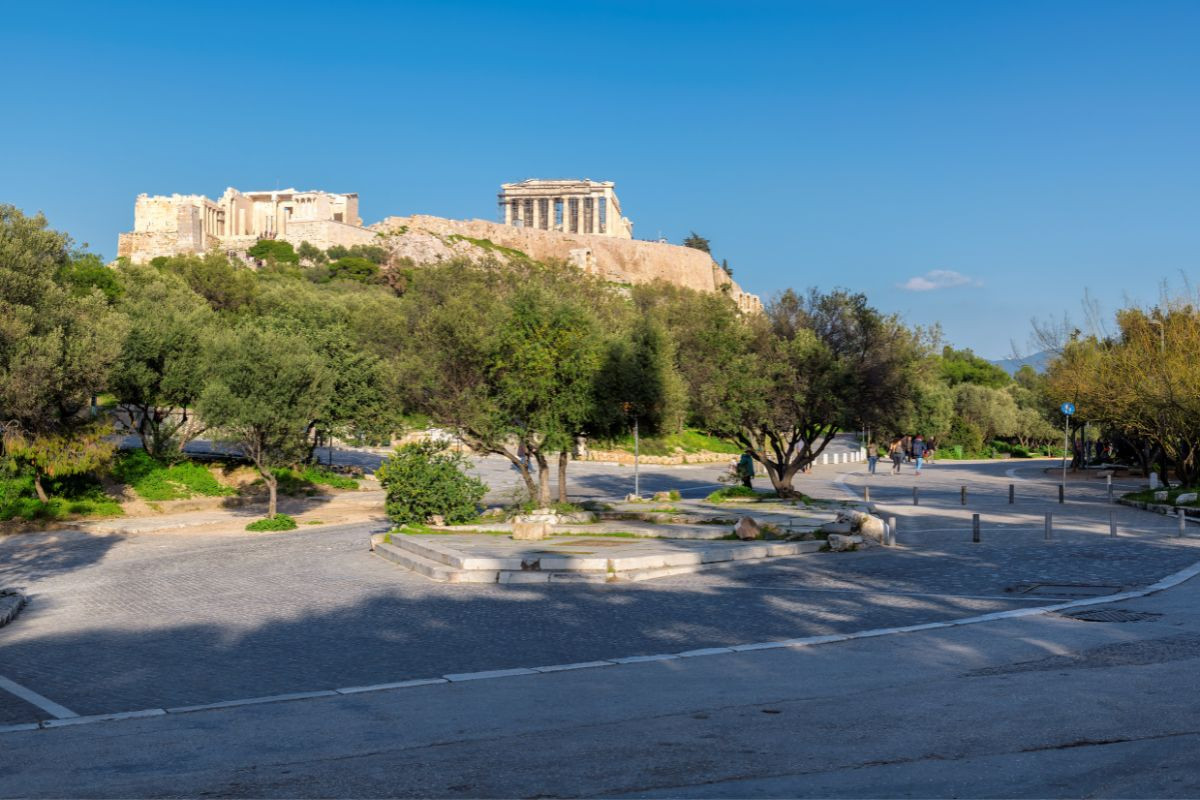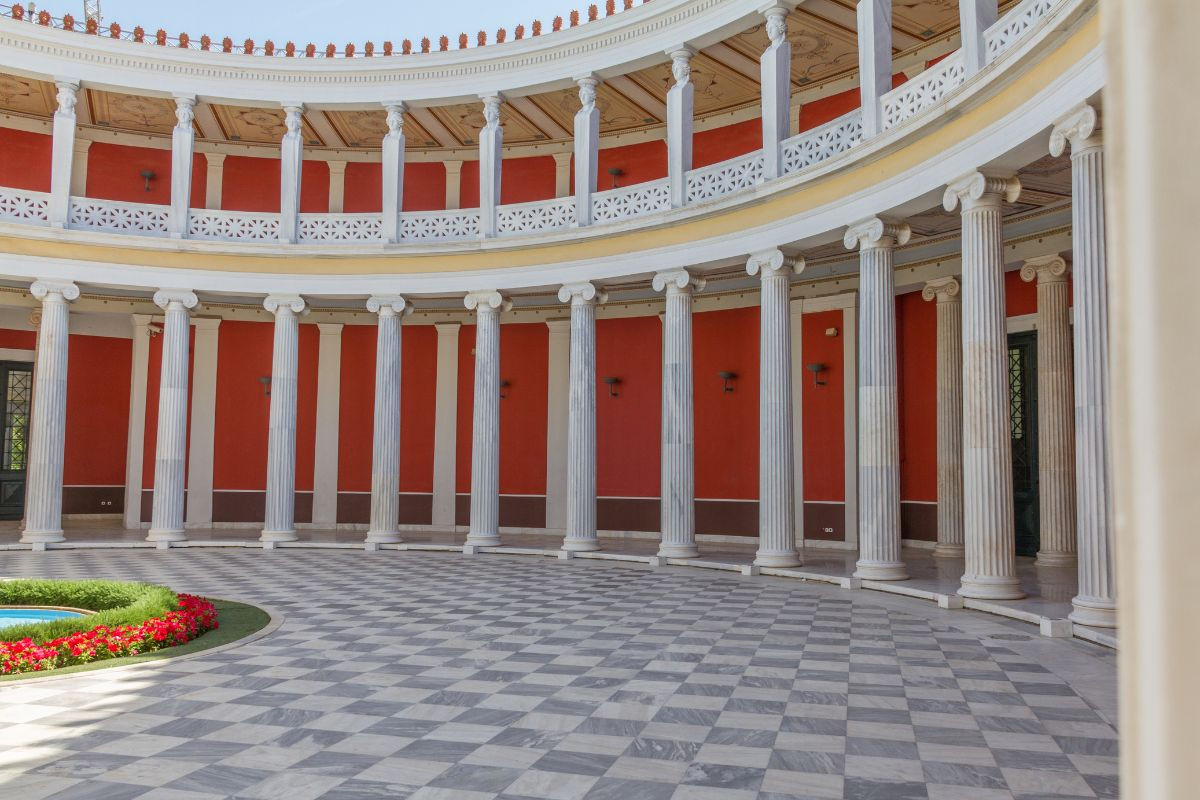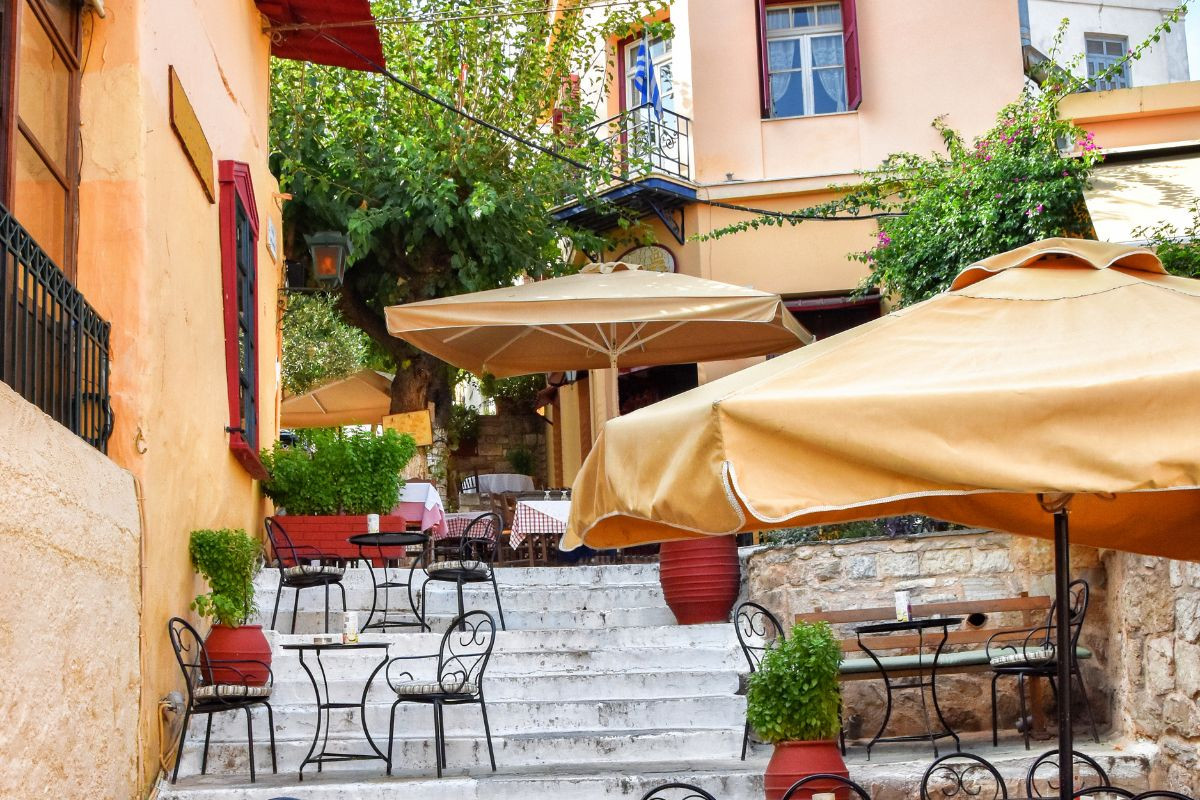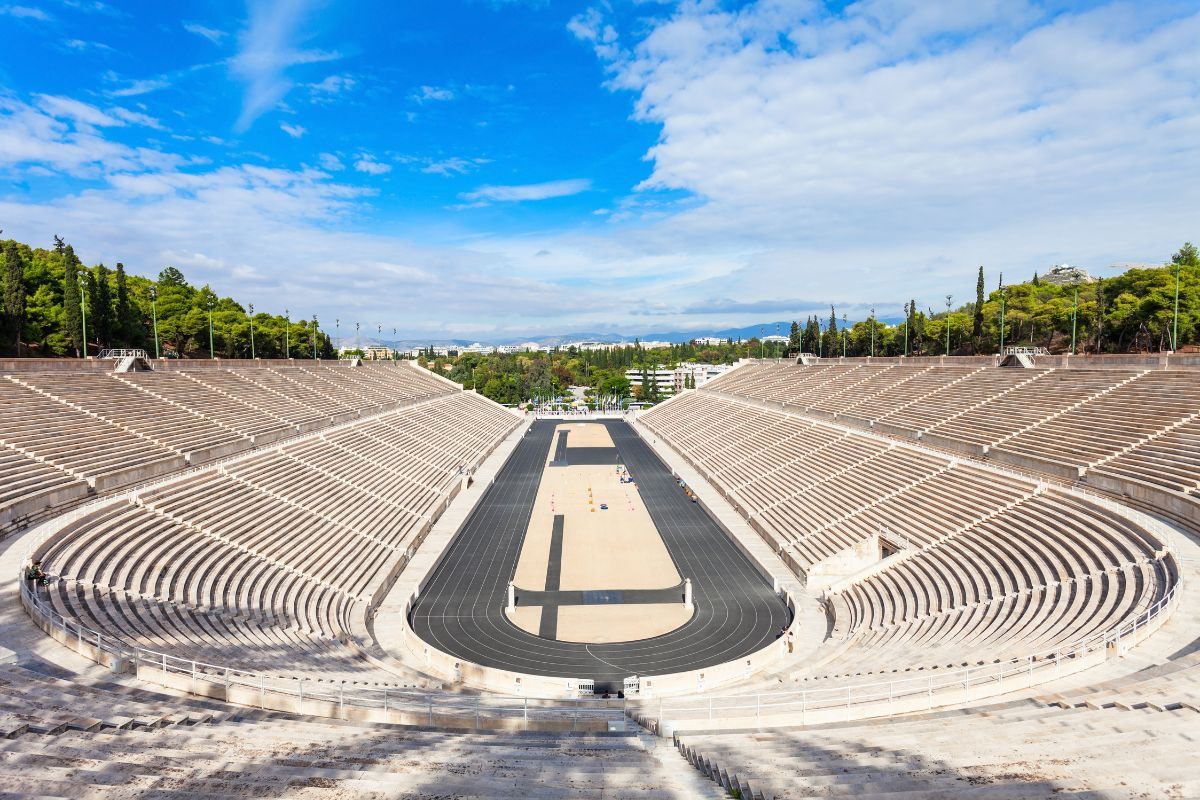Athens offers a balanced mix of history and culture, perfect for your 48-hour visit to Athens.
Here's what to do in Athens in 2 days, whether you're passionate about history, arts, or simply looking to explore. Enjoy your trip!
Athens, with its historical significance and lively culture, can be a lot to take in for first-time visitors. This guide is here to help. It will highlight the city’s key attractions and activities, all achievable within a two-day visit.
If you’re looking to maximize your short stay in Athens, this guide is for you. It will unveil Athens’ lesser-known spots, famous landmarks, and memorable experiences. Explore Athens, a city that beautifully blends ancient roots with contemporary charm.

Arriving in Athens from Athens International Airport is straightforward due to several convenient transportation options. Here's a quick guide on how to get to the city center:
The Metro Line 3 connects the airport to the city center. It’s a cost-effective choice with frequent trains. The journey takes around 40 minutes. Syntagma and Monastiraki are the recommended stations to disembark.
The Airport Express Bus is a good option if you have heavy luggage. It takes about 60 minutes to reach the city center.
Taxis are available at the airport. They are pricier but can save time. Always insist on using the meter to avoid overcharging.
For a smooth start to your Athens trip, consider pre-booking a private transfer. This is especially useful if you have special needs or are traveling in a large group.

Navigating Athens offers various transportation options tailored to your itinerary and preferences.
Walking is particularly enjoyable in the historic center areas like Plaka and Monastiraki. Here, you can meander through charming streets, discovering local cafes and vibrant neighborhoods while enjoying the city’s ambiance.
The metro system in Athens is another efficient choice, especially for visiting major sites like the Acropolis and Syntagma Square. It operates from early morning until late, linking crucial parts of the city with clear station signage.
For areas beyond metro reach, the extensive bus and trolleybus network serves well. Use the blue city buses or green trolleys, with tickets purchasable at kiosks or on board.
To enjoy views along the Athenian Riviera, the tram is ideal, connecting to coastal neighborhoods such as Glyfada and Voula.
Taxis provide a more direct, though costlier, transportation method. Ensure the meter is running to keep costs transparent.
Electric scooters are an increasingly popular and fun option for short distances, available through various rental services.
For trips outside the central area, renting a car might be beneficial. This allows freedom to explore Athens' outskirts and nearby sites at your leisure.

Visiting Athens during the spring months of April and May is highly recommended. The city is vibrant with blooming flowers, and the mild temperatures, ranging from 15°C to 25°C (59°F to 77°F), make it comfortable for exploring historical sites and wandering through quaint neighborhoods without enduring the intense summer heat. This period also tends to offer fewer crowds and more affordable accommodation.
The summer months from June to August mark the peak tourist season in Athens, where the city enjoys hot Mediterranean weather, with temperatures often between 30°C and 38°C (86°F to 100°F). This is the prime time for beach activities and sunbathing. Expect significant crowds at popular attractions and higher accommodation costs. If you're okay with the heat and bustling environment, summer offers a lively atmosphere.
Autumn, from September to November, mirrors spring with favorable conditions for a visit. Temperatures remain warm, from 18°C to 30°C (64°F to 86°F), and the diminishing summer crowds make it easier to enjoy the city’s sights. Our experience in September was outstanding, though October and November also provide pleasant weather for sightseeing.

Choosing the right neighborhood for your stay is crucial when visiting Athens, as each area offers its own unique vibe and amenities. Here are some of the top neighborhoods to consider for your trip:
This area is one of the most scenic parts of Athens, located right under the Acropolis. It features a network of quaint streets lined with neoclassical architecture, charming tavernas, and boutique shops. Staying in Plaka provides easy access to major historical sites like the Acropolis and the Ancient Agora, offering a vibrant atmosphere steeped in the city's history and culture.
Known for its bustling flea market, Monastiraki is a lively neighborhood filled with cafes, restaurants, and stores, making it a great spot for souvenir hunting. It's conveniently close to Plaka and has excellent metro connectivity, including direct links to the airport.
The commercial and political heart of Athens, this area is surrounded by luxury hotels and upscale shopping options. It's near the Greek Parliament and the National Garden, with easy access to historic Plaka and excellent public transport services.
Recently recognized as one of the trendiest districts, Koukaki is near the Acropolis and known for its laid-back charm. The neighborhood hosts a variety of traditional eateries, modern shops, and cool bars, with the Acropolis Museum and Herodion Theater just a stroll away.
Celebrated for its vibrant nightlife and street art, Psiri offers an energetic, bohemian experience with plenty of music venues, bars, and restaurants. It presents a more alternative take on Athens, though it may feel less comfortable to walk around at night.
Situated beneath Lycabettus Hill, this posh neighborhood is akin to Athens' own Beverly Hills, featuring high-end boutiques, gourmet cafes, and fine dining. It's ideal for those looking for a touch of luxury during their stay.
Each of these neighborhoods provides a different perspective on Athens, catering to various tastes and preferences, whether you're seeking history, culture, or modern amenities.

Start your visit in the picturesque area of Plaka. Wander through the enchanting Anafiotika neighborhood. Take a leisurely walk through the National Garden and admire the grandeur of the Zappeio. Explore historic sites like Hadrian’s Arch and the Temple of Olympian Zeus. Make a stop at the Panathenaic Stadium. Witness the changing of the guards at the Hellenic Parliament. Spend some time at the National Archaeological Museum, or opt for a visit to the Acropolis Museum.
Begin with the iconic Acropolis and its surrounding slopes. Continue to the Ancient Agora, then explore the historic district of Kerameikos. Wander around the lively area of Psiri and head to Monastiraki Square. Enjoy lunch at a rooftop bar with views of the Acropolis. Visit historical landmarks like Hadrian’s Library and the Roman Agora. If time permits, explore the Monastiraki Flea Market or the Central Market. Shop along Ermou Street and end your day at Syntagma Square. For a memorable sunset, climb Mount Lycabettus, or alternatively, visit Areopagus Hill or Filopappou Park.

Your initial day in Athens spans two neighborhoods and the vicinity of the National Garden, featuring several historical sites. This sets a calm commencement to your Athens visit.
Plaka, the “Neighborhood of the Gods,” is located at the base of the Acropolis. It’s a favorite district in Athens.
As daylight breaks, navigate Plaka’s maze-like streets, filled with neoclassical buildings, Byzantine churches, and balconies draped with bougainvillea.
Venture into the slim lanes, home to small shops and boutiques offering local artifacts and souvenirs. Plaka is recognized for its handmade crafts, jewelry, and distinctive mementos.
Pause at a local cafe for a traditional Greek breakfast. Enjoy Greek yogurt with honey and nuts, complemented by a robust coffee. Plaka also hosts delightful tavernas and authentic Greek restaurants, many found on Adrianou Street. Sample baklava or a fresh spanakopita at a local bakery, a true taste of Greek cuisine.
Art lovers will value the numerous art galleries and boutiques throughout Plaka. Discover the creations of local artists and perhaps find a unique artwork to take home.
Wandering around Plaka, getting lost in the scenic streets while occasionally spotting the towering Acropolis, was particularly enjoyable.
Close to Plaka, you’ll find Anafiotika, a hidden neighborhood within the city. It’s like a piece of the Greek islands in the heart of Athens, known for its photogenic appeal.
After exploring Plaka in the morning, take a brief walk to Anafiotika. Entering this district, you’ll find narrow paths, white houses, and vibrant flowers adorning balconies, creating a picturesque setting.
Wander through the maze of streets, and you’ll feel as if you’ve arrived at a Greek island. The architecture is distinctly Cycladic, similar to Santorini and Mykonos. Capture the charming scenes and enjoy the peaceful atmosphere of this secluded corner.
Anafiotika is a residential area, offering a glimpse into local life. Residents often gather outside their homes for conversations, contributing to the genuine Greek ambiance. Please remember to respect their privacy and enjoy the serene pace of this captivating neighborhood.
Venture to the higher parts of Anafiotika for panoramic views of Athens. From these vantage points, you can see the Acropolis, Lycabettus Hill, and the city below. It’s a great spot for photography and appreciating Athens’ beauty from a unique viewpoint.
After touring Plaka and Anafiotika, visit the National Garden, a green retreat in Athens’ center.
The National Garden, formerly the Royal Garden, was the Royal Palace’s private garden. Now, it’s a public park offering a break from the city’s pace and is a top free activity in Athens.
Entering this verdant sanctuary, you’ll see tall palm trees, pine groves, and a calm pond. The garden is a paradise for nature lovers, with a variety of plant species, from exotic trees to Mediterranean shrubs.
Look out for the pond’s turtles and the free-roaming peacocks, adding charm to this tranquil haven.
The National Garden also houses historical landmarks, including an ancient temple dedicated to Diana, adding a historical touch to the greenery.
A visit to the National Garden is a refreshing way to unwind during your 2-day Athens trip. It’s a serene getaway that lets you connect with nature and offers a break from the city’s lively energy.

The National Garden houses the Zappeion Hall, a neoclassical marvel with a storied past. This notable edifice has been the venue for numerous events and displays. Its grand architecture, detailed with precision, reflects Greece’s cultural legacy. A stroll in the garden offers a view of Athens’ history through the enduring appeal of its architectural gems.
Close to the National Garden is Hadrian’s Arch, a tribute to Emperor Hadrian. This impressive marble archway was once the main entrance to ancient Athens. A brief walk from the arch brings you to the Temple of Olympian Zeus, previously the biggest temple in ancient Greece. Its massive Corinthian columns remain, showcasing the architectural splendor of the past. These adjacent landmarks highlight Athens’ historical significance and are recommended for history buffs.
The Panathenaic Stadium, or Kallimarmaro, is a significant symbol of athletic heritage in Athens. It’s the world’s only stadium made entirely of white marble, reflecting ancient Greece’s magnificence. It has a rich history, having hosted the inaugural modern Olympic Games in 1896.
The competitive spirit is palpable as you traverse the stadium’s impressive, horseshoe-shaped arena. Walking on the revered track, one is moved by the resonance of previous athletic triumphs.
After exploring the National Garden and its surroundings, head to the Hellenic Parliament building for a renowned event: The Changing of the Guards at the Hellenic Parliament is an essential Athens experience.
The Evzones, Greece’s elite ceremonial infantry, guard the Tomb of the Unknown Soldier in front of the Parliament building near Syntagma Square. This captivating event occurs every hour as the guards, in their unique uniforms, execute a meticulously coordinated and solemn ceremony.
On Sundays, the main Changing of the Guards is a more extensive event, with a full military band and a more complex ritual. This occasion attracts a larger audience and showcases an even more striking demonstration of military precision. It’s a fascinating and patriotic custom that highlights Greece’s abundant heritage and military past.
An Athens tour isn’t complete without a stop at the National Archaeological Museum, a repository of Greece’s ancient history. With an unmatched assortment of artifacts, the museum provides an intriguing look into Greece’s vibrant past and culture.
Explore its spacious galleries to discover stunning sculptures, detailed pottery, and invaluable artifacts that narrate the tales of ancient Greece. The museum is a genuine historical journey, highlighting the marvels of the Mycenae, Cyclades, and Minoan civilizations.
Consider a visit to the Acropolis Museum. It displays the Acropolis artifacts, including the renowned Parthenon sculptures. The museum’s design reveals ancient excavations beneath a glass floor.
Unlike the National Archaeological Museum’s broad collection, the Acropolis Museum focuses on the Acropolis’s past. It provides a contemporary experience that supplements the National Archaeological Museum’s wider range.
The Acropolis Museum operates daily, with varying hours based on the day and season.

Start your day with a visit to Athens’ primary attraction, the Acropolis. This UNESCO World Heritage site is a testament to Greece’s rich history.
The Acropolis houses four notable structures: The Propylaea, the Parthenon, the Temple of Athena Nike, and the Erechtheion.
The Propylaea greets you with its Doric columns as you approach the Acropolis. The Parthenon, a marvel of architecture, stands as the Acropolis’ main attraction. The Temple of Athena Nike, dedicated to the victory goddess, showcases ancient Greek architectural finesse. Lastly, the Erechtheion, known for its Caryatids - sculpted female figures acting as pillars, is a sight to behold.
Don’t overlook the Acropolis slopes, home to the Odeon of Herodes Atticus and the Theater of Dionysus. The former, a well-preserved ancient theater, hosts concerts and performances. The latter, the origin of Greek drama, once resonated with the works of renowned playwrights like Aeschylus, Sophocles, and Euripides.
The Acropolis, a fusion of ancient history, remarkable architecture, and mythology, is a must-visit in Athens.
Following your visit to the Acropolis, consider the Ancient Agora of Athens. This site was central to the city’s political, social, and commercial life in ancient Greece.
The ruins include the Temple of Hephaestus, the Stoa of Attalos, and the Horologion of Andronikos. The Ancient Agora’s historical significance makes it a compelling and essential attraction in Athens.
This trip into the past enhances your understanding of ancient Greek civilization. Highlights include the grand hall, the view of the Acropolis, and the preserved Temple of Hephaestus.
Just a brief walk from the Ancient Agora, you'll find Kerameikos, another significant archaeological site accessible with your combo ticket. This ancient cemetery provides a fascinating glimpse into the funerary traditions of ancient Athens.
As you explore, you'll come across well-preserved tombstones and detailed sculptures, including the impressive Dipylon Gate, which historically served as the main entrance to the city's burial grounds.
Visiting Kerameikos offers a moment to reflect on the life, death, and rituals of the ancient Athenians. It stands as a site of great historical and cultural importance, offering insights that enrich your understanding of ancient Athens. This makes Kerameikos a poignant addition to your exploration of the city's past.
Explore Psiri, Athens’ vibrant quarter. This area is known for its artistic flair and vivid street art. It hosts a variety of music venues, bars, and small restaurants. Psiri presents a mix of modern and traditional, with ancient Orthodox churches amidst contemporary street art.
The district becomes more dynamic at night, filled with music and people in the busy squares. Psiri offers a glimpse into Athens’ unconventional side. It’s an essential visit for those who appreciate art and a spirited environment.
Monastiraki Square is a dynamic area where Athens' historical depth and lively market culture meet. This busy central square is not only a key transit point with the Monastiraki Metro Station but also a place rich in history. The Tzistarakis Mosque, an 18th-century Ottoman monument, stands as a significant historical feature enhancing the square's character.
Surrounding the square, a network of narrow streets and alleys are bustling with shops. These offer a range of items from antique finds and handmade crafts to vintage clothing and local street food, making Monastiraki Square a must-visit for both its cultural significance and shopping opportunities.

Take a break and enjoy lunch at a rooftop bar near Monastiraki Square. We selected the Attic Urban Rooftop bar for its delightful snacks, drinks, and stunning Acropolis view. Experiencing Greek cuisine against this scenic backdrop was memorable.
We suggest visiting a rooftop bar during your 2-day Athens trip. Consider dining at a rooftop bar at sunset next time. Remember to make reservations for the sunset slot to secure your spot.
Continue your exploration of Athens with visits to Hadrian's Library and the Roman Agora, two of the city's well-preserved remnants from its Roman era. Hadrian's Library was once a major educational hub, filled with countless scrolls and texts, while the Roman Agora served as the bustling commercial center.
As you stroll through the ancient columns, statues, and ruins, you'll gain insights into the daily life and culture of ancient Athens. These sites not only offer a connection to the past but also enhance your understanding of the city's rich historical tapestry.
Ermou Street, linking Monastiraki Square and Syntagma Square, is a top-notch shopping destination. This vibrant pedestrian street is lined with a variety of boutiques, global brands, and local stores. It caters to all your shopping needs, be it clothing, accessories, or keepsakes. Ermou Street provides an enjoyable shopping atmosphere in central Athens.
To get there from Monastiraki Square, just continue along the street until you reach Syntagma Square.
Syntagma Square is the civic and political heart of Athens, marked by its historical significance and the iconic Hellenic Parliament building. Perhaps you recall seeing the Changing of the Guards here on your first day. The square is flanked by historic hotels, stylish boutiques, and open-air cafes, making it a prime location for people watching. It serves as a popular gathering spot for both locals and tourists, and acts as a central point for delving into Athens' lively cultural and historical scenes. Additionally, Syntagma Square is conveniently served by a metro station, facilitating easy access to the rest of the city.
As your day in Athens draws to a close, consider ending it with a sunset view from Mount Lycabettus. This prominent hill, the highest in the city, provides a memorable panoramic view of Athens as it lights up at dusk. To reach the summit, you can either take a leisurely walk or use the Lycabettus Funicular tram for an easy ride to the top (7€ one way, 10€ return). Regardless of your choice, the payoff is the same - a stunning sunset illuminating the Acropolis, the cityscape, and the distant Aegean Sea.
Exploring Athens in 2 days offers a whirlwind tour through a city steeped in history and brimming with vibrant life. From the ancient grandeur of the Acropolis and its surrounding historical sites to the bustling streets of Monastiraki Square and the political hub of Syntagma Square, Athens presents a dynamic blend of the old and the new. Each site, from Hadrian's Library to the Roman Agora, contributes to a deeper understanding of this storied city. By following this concise itinerary, you can effectively capture the essence of Athens, making the most of your short visit.